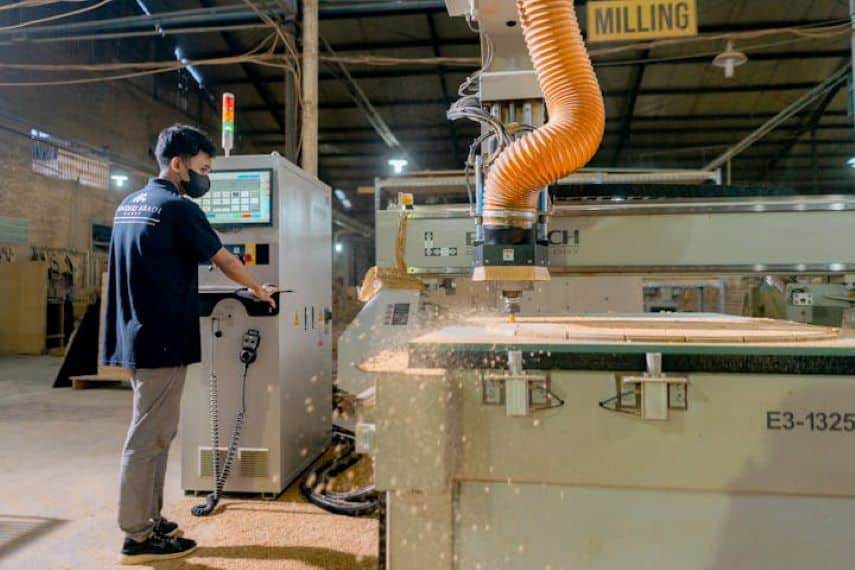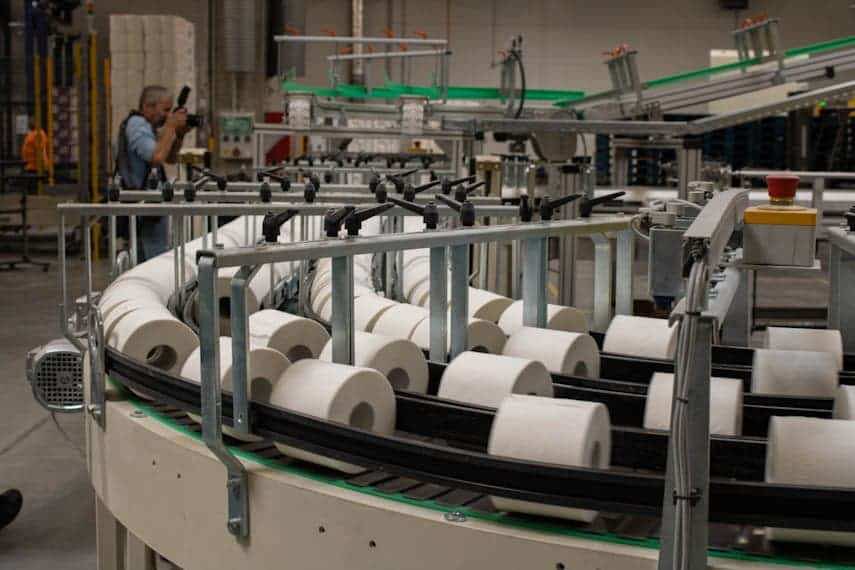
The manufacturing industry thrives on efficiency gains. Any opportunity to minimise waste and reduce your business costs means greater revenue, higher profits, and happier customers.
Just-in-time (JIT) manufacturing is a production management approach that helps you lift efficiency and streamline your operational processes. Here’s how it works.
What is just-in-time manufacturing?
Just-in-time manufacturing is a strategy that directly aligns raw-material supply deliveries with production schedules to increase efficiency and decrease waste. This system requires accurate demand forecasting and involves receiving goods only as they are needed in the production process.
Implementing JIT in manufacturing operations can significantly reduce lead times and inventory levels, leading to cost savings and more responsive production cycles. It's particularly beneficial for companies looking to minimise storage space and reduce capital tied up in unsold stock.
Just-in-time and lean manufacturing
Just-in-time manufacturing and lean manufacturing are two pivotal strategies implemented in modern production processes, which focus on manufacturing efficiency and waste reduction.
JIT manufacturing aligns production with customer demand. It ensures that goods are produced only as they are needed. Lean Manufacturing aims to streamline production by eliminating non-value-adding activities, enhancing efficiency, and reducing costs.
The just-in-time approach contrasts with just-in-case strategies, where producers hold sufficient inventories to absorb maximum market demand. The lean manufacturing approach is a departure from non-value-added activities like overproduction, excess motion, waiting times, and unnecessary processing steps.
Both just-in-time manufacturing and lean manufacturing attempt to avoid inventory that ties up capital, sits in storage taking up space, potentially leading to obsolescence, and contributes no extra value to customer satisfaction or the production process. All of which are costly to your businesses.
JIT manufacturing example
Dell’s computer manufacturing demonstrates the effectiveness of JIT in the technology manufacturing sector. The JIT model at Dell involves a sophisticated supply chain system where components are procured and assembled only as needed to produce computers with a high degree of customisation.
JIT is a pivotal element in Dell’s operational efficiency that allows the company to maintain minimal inventory, reduce waste, and increase the speed of its production cycle.
The success of Dell's JIT implementation is evident in its ability to deliver tailored products with reduced lead times and lower inventory costs. By aligning their manufacturing process closely with customer orders, Dell can effectively respond to market demands and maintain a competitive edge.
 Just-in-time manufacturing is an effective strategy for reducing excess inventory in production.
Just-in-time manufacturing is an effective strategy for reducing excess inventory in production.
Lean manufacturing examples
Nike has collaborated with NGOs and manufacturers to create sustainable sourcing, which has resulted in significant energy and material savings. While Intel's adoption of lean manufacturing tools has dramatically reduced the time to bring a new chip to the factory from weeks to days, highlighting a clear enhancement in their operational efficiency.
Toyota, renowned for its Toyota Production System, sets the benchmark in the industry incorporating lean principles to enhance efficiency, reduce production times and improve product quality.
These examples highlight how lean manufacturing can lead to tangible improvements in production processes, cost savings, and environmental sustainability. The evidence of successful lean implementation is often reflected in the increased efficiency, reduced waste, and improved customer satisfaction that these companies report.
 Lean manufacturing and just-in-time systems work well together, as both strive to attain maximum efficiency gains.
Lean manufacturing and just-in-time systems work well together, as both strive to attain maximum efficiency gains.
Advantages of just-in-time manufacturing
JIT manufacturing aligns material orders with production schedules, ensuring goods only arrive as needed for the manufacturing process.
Ultimately, the success of JIT manufacturing hinges on the seamless integration of supply chains, quality control, and accurate demand forecasting.
When implemented effectively, JIT can lead to a more responsive and efficient production system, but it requires a commitment to continuous improvement and problem-solving to address the inherent risks and challenges of this approach.
Advantages of JIT manufacturing include:
- Reduced storage and financing costs
- Shorter production lead times
- Less waste
- No overproduction
- Greater resource efficiency
- Better cash flow
- Shorter throughput times
- Increased responsiveness to market changes
One of the main benefits of just-in-time manufacturing is the reduction of inventory levels, which helps manufacturers avoid excess costs associated with storage and inventory management. By producing goods only as they are needed, companies can minimise the amount of capital tied up in unsold products and lower the risk of inventory obsolescence.
JIT also contributes to improved quality management, as the production process becomes more streamlined and responsive to immediate demand. This can lead to shorter lead times, quicker turnaround on orders, and increased customer satisfaction. Additionally, JIT can result in lower labour costs due to the elimination of unnecessary handling and storage of materials.
Implementing JIT can lead to significant improvements in efficiency and waste reduction, but it requires a long-term commitment to nurturing an environment that embodies the flexibility, efficiency, and meticulous quality control that JIT demands.
This can be particularly beneficial in industries such as craft beer, craft distilleries, supplements, and food manufacturing, where consumer preferences can change rapidly, and products often have limited shelf lives.
Here are some examples:
- In the context of food manufacturing, an effective just-in-time production strategy means ordering ingredients in precise quantities based on real-time demand, thus minimising waste and ensuring freshness. JIT demands meticulous planning, a culture of continuous improvement, and responsiveness to meet the dynamic needs of the food market.
- For a craft beer manufacturer, JIT could involve closely monitoring sales trends and customer feedback to predict demand more accurately. This would allow the brewery to produce beer in quantities that meet current demand without overproducing, thus reducing the risk of spoilage and excess inventory.
- In a craft distillery, they might use JIT to manage the production of spirits, ensuring that each batch is distilled based on actual orders rather than speculative forecasting. This helps in maintaining the freshness of the product and reducing storage costs.
- In the supplements industry, where products are sensitive to expiration dates, JIT can help in managing the procurement of raw materials and the production of supplements so that they are made to order, ensuring maximum potency, and minimising the risk of having unsold stock that goes out of date.
- For lighting manufacturers, JIT can streamline the production process by synchronising the assembly line with real-time sales data, thus avoiding overproduction, and enabling quicker response to market trends, such as the rise in demand for energy-efficient LED lighting.
Disadvantages of just-in-time manufacturing
The main disadvantages of just-in-time manufacturing include the risk of running out of stock caused by the system's reliance on accurate demand forecasts. If these forecasts are incorrect, a manufacturer may not have enough inventory to meet consumer needs.
Disadvantages of JIT manufacturing include:
- A dependency on accurate demand forecasts
- Vulnerability to supply chain disruptions
- Potential for increased stress on workers due to the need for precision timing
JIT systems also have little room for error or unexpected demand surges, as they maintain minimal inventory levels. This can lead to production bottlenecks if suppliers experience delays or disruptions.
Additionally, the minimised inventory holding in JIT can result in quality control issues, as there is less opportunity to inspect goods over time. Implementing JIT requires a robust and responsive supply chain, which can be a significant challenge for some businesses.
The balance between the advantages and disadvantages of just-in-time manufacturing must be carefully managed to ensure that the system delivers on its promise of increased efficiency and reduced waste.
 Consider the advantages and disadvantages of JIT manufacturing to make an informed decision about whether it's right for you.
Consider the advantages and disadvantages of JIT manufacturing to make an informed decision about whether it's right for you.
How JIT manufacturing works
The steps to implementing JIT into your manufacturing operations typically begin with an analysis of your current processes to identify areas of waste, such as excess inventory or overproduction.
Then, you create a production flow to minimise this waste and maximise efficiency.
The JIT approach contrasts with just-in-case strategies, where producers hold sufficient inventories to absorb maximum market demand.
Key elements of JIT manufacturing:
- Continuous improvement
- Waste elimination
- Quality management
- Pull processing
- Flexibility
- Supplier integration
Continuous improvement focuses on constantly refining processes tasks and activities, while waste elimination targets unnecessary aspects like waiting times and excess inventory.
Quality management is crucial as defects can lead to waste and pull processing will ensure production is based on actual demand rather than demand forecasts. Your suppliers must be integrated into the process to deliver materials as needed.
Finally, flexibility in your workforce and machinery is a must to quickly adapt to changes as necessary.
Sophisticated planning tools are essential for the success of JIT, as they help to maintain steady production, ensure high-quality workmanship, and avoid breakdowns of machinery and equipment. Manufacturers must have accurate and frequently updated sales forecasts, supported by a proven, reliable supply chain to mitigate these risks.
Just-in-time manufacturing systems
Just-in-time manufacturing systems have been adopted by various industries and work by producing goods in small batches and only when they are needed.
This means there is little or no excess inventory, leading to substantial cost savings on storage and handling, smaller investments in inventory stock, and elimination of waste due to unsold or spoiled goods.
The evolution of JIT continues as companies strive to refine their processes and respond to the dynamic demands of the global market. Advancements in technology and strategy are reshaping JIT manufacturing, making it more efficient and responsive to the dynamic market conditions.
Manufacturing inventory management software is an essential tool for implementing JIT manufacturing. It helps you accurately forecast demand, optimise stock levels, and reduce waste.
 Just-in-time manufacturing systems work by minimising inventory and waste to prevent overproduction.
Just-in-time manufacturing systems work by minimising inventory and waste to prevent overproduction.
How to implement an effective just-in-time production strategy
Implementing an effective just-in-time production strategy in manufacturing requires a comprehensive approach that encompasses several key steps and principles. The core idea of JIT is to align production schedules closely with market demand, thereby minimising inventory levels and reducing waste.
Key considerations when implementing JIT:
- Understanding the demand forecasts
- Ensuring your production capacity meets product demand
- Building strong, mutually beneficial relationships with reliable suppliers
- Have steady production and high-quality workmanship
- Maintaining glitch-free plant machinery and equipment
- Empowering a culture that embraces continuous improvement
The implementation of JIT across these industries requires a thorough assessment of your current manufacturing processes to identify areas of waste and inefficiency. This may involve analysing production cycles, inventory levels, and supplier relationships.
Here’s how to implement just-in-time manufacturing in six steps.
1. Get your staff involved in the process
It's crucial to involve your workforce in the transition to JIT because their cooperation and understanding are essential for the success of this strategy. Investing in cross-training your employees is beneficial, it increases the flexibility of your workforce, allowing staff to perform multiple tasks and adapt to changing production needs.
2. Build healthy supplier relationships
Establishing strong, mutually beneficial relationships with suppliers is also key, as successful JIT manufacturing depends on its ability to deliver smaller batches of materials more precisely and frequently when needed.
3. Implement real-time inventory tracking
A robust inventory management system is also critical, as traditional methods may not support the dynamic nature of JIT. Implementing a pull system, where production is driven by customer demand rather than forecasts, is a fundamental aspect of JIT.
4. Improve production processes
Streamlining the production layout to reduce movement and handling can also contribute to greater JIT efficiency. Minimising unnecessary movement and handling aligns with lean manufacturing principles, which focus on eliminating non-value-added activities and ensuring that every step in the production process adds value to the final product.
5. Factory layout optimisation
A well-organised production design facilitates better inventory management, reduces the risk of damage to materials and products, and can improve worker safety by reducing clutter and potential hazards.
6. Keep getting better
Continuous improvement, a principle of Kaizen, is integral to JIT, as it involves consistently refining processes to enhance quality and efficiency. This continuous cycle of evaluation and improvement helps you to maintain a competitive edge.
Just-in-time manufacturing in summary
In conclusion, implementing JIT into your manufacturing operation is a strategic decision that can lead to significant improvements in efficiency, cost savings, and customer satisfaction.
By focusing on producing what is needed when it is needed, manufacturers can reduce waste, improve product quality, and respond more swiftly to shifts in consumer demand.
JIT manufacturing systems exemplify a shift towards more agile and cost-effective production methods. While they offer significant advantages in terms of efficiency and waste reduction, they also demand a high level of precision and coordination, making their implementation a strategic decision that must be carefully considered against potential risks and challenges.
For those willing to embrace these changes, JIT can be a powerful tool in achieving operational excellence.
